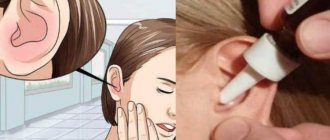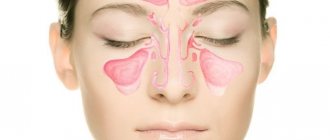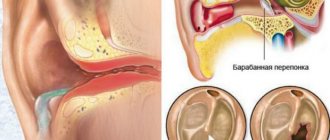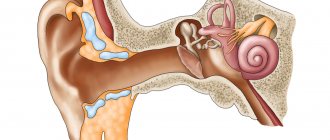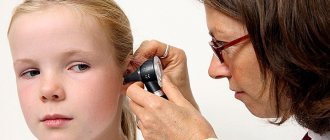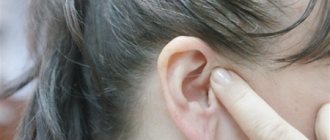What is catarrhal otitis and how does it differ from regular otitis?
In an acute inflammatory process, not only the eardrum itself is affected, but also the entire auditory tube and mastoid processes.
With catarrhal otitis, the entire cavity of the middle part of the ear apparatus is affected. Often, pathogenic microflora enters the middle ear cavity through the nasopharynx or oropharynx with the development of acute rhinitis, respiratory viral disease or influenza.
This happens if a person blows his nose incorrectly, during coughing or sneezing, when pressure is created on the eardrum and mucus easily penetrates into the ear cavity. The disease is treated by an otolaryngologist.
The development of the disease is characterized by tissue swelling, general intoxication of the body, and fluid accumulation as a result of an acute inflammatory process. Such processes disrupt the drainage and ventilation function of the auditory organ, and the quality of hearing deteriorates significantly.
Causes
Acute catarrhal otitis in a child can be provoked by such unfavorable factors as:
- Frequent colds, acute respiratory viral infections or acute respiratory infections;
- Chronic processes in the nasopharynx;
- Constantly inflamed adenoids;
- Cough not cured in time.
In addition to the reasons that may provoke inflammation in the baby’s ear, do not forget about the baby’s anatomical predisposition to such diseases. The fact is that the Eustachian tube in newborns has slightly different parameters than in adults.
It is unusually short in length, but at the same time very wide - this structure allows pathogens to enter the cavity of the middle ear and nasopharynx.
If catarrhal otitis affects a small patient, then the first thing the doctor should do is to determine the cause and causative agent of the disease. Most often, these are streptococcal or staphylococcal infections. In more rare cases, the disease is caused by pneumococcal bacteria.
Child factors
Babies are most susceptible to the disease, which is explained by their anatomical features. Children have a wide Eustachian tube, but it is short. When regurgitating, sneezing, coughing, pathological microorganisms enter the middle ear cavity.
The horizontal position in which children under one year of age often spend time, as well as the predisposition of the mucous membranes of babies to quickly dry out, are contributing factors to the recurrence of catarrhal otitis in children and its further transition to a chronic form.
Danger of ear infections
Advanced catarrhal otitis media can cause a decrease in
Catarrhal otitis is a typical inflammatory process in the ear associated with infectious damage to local tissues. The degree of its danger is great, since inflammation in any part of the ear apparatus can become complicated and provoke the development of serious disorders.
In the absence of proper therapy or its untimely organization, otitis media provokes hearing problems. The main complication of the pathology is a decrease in its level up to complete deafness. If you do not react to such a set of circumstances in time, you can start a pathological process, making it irreversible.
Less commonly, the consequences of catarrhal otitis manifest themselves differently. The main complications of this pathology, in addition to the development of hearing problems, are:
- rupture of the eardrum, causing deafness
- the appearance of chronic inflammation
- labyrinthitis
- mastoiditis
- meningitis
As you can see, complications of catarrhal otitis develop far beyond the hearing aid. An untreated illness can cause serious brain damage, sometimes incompatible with life. Because of this state of affairs, a lenient attitude towards inflammation in the ear cavity is unacceptable, which should be clear to absolutely any person.
Complications
The main complication of catarrhal otitis is considered to be its transition to both ears, the occurrence of pus and the development of chronic otitis. This increases treatment time and increases the chances of developing undesirable consequences.
These include hearing loss and deafness. Since a ruptured eardrum does not always heal, which significantly affects hearing. Sometimes labyrinthitis occurs as a complication of catarrhal otitis. This is an inflammation of the labyrinth of the ear. Possible inflammatory complications include mastoiditis and meningitis. The latter disease has a high mortality rate.
Symptoms
Catarrhal otitis media in children is accompanied by such symptoms as ear congestion, increased temperature, painful pulsating sensations in the affected ear, hearing impairment, pain can radiate to the teeth, temples, and back of the head. The pathological process most often affects one ear; bilateral inflammation develops in rare cases.
Very often, the development of catarrhal otitis is accompanied by autophony - a person hears his own voice in the affected ear. Gradually, the middle ear cavity is filled with a serous mass, autophony decreases, and tinnitus, on the contrary, becomes more pronounced.
A characteristic manifestation of catarrhal otitis is severe pain that occurs when pressing on the tragus. With further development of the inflammatory process, the painful sensations intensify.
The addition of shooting pain further aggravates the patient’s condition, causing malaise and increased fatigue. Body temperature can reach 38 ºС and above. In this state, the child refuses to eat, is indifferent to toys, and does not make contact.
As the symptoms of intoxication in the body intensify, the state of health worsens, and vomiting and convulsions may develop.
In the absence of adequate treatment at this stage, acute catarrhal otitis in a child turns into a purulent form.
Symptoms of the disease
Otitis in a child manifests itself with a lot of symptoms. They are divided into two groups: specific and nonspecific. The second type includes symptoms of general intoxication:
- temperature rise above 38ºС;
- anxiety;
- weakness;
- decreased physical activity;
- difficulty eating;
- a sharp decrease in appetite;
- dyspeptic disorders (diarrhea, vomiting).
This is how catarrhal otitis media manifests itself in young children. In adolescents and adults, some symptoms may be absent due to the presence of a developed immune system and the eustachian tube.
Otitis media also has specific symptoms. These include:
- shooting pains inside the ear;
- hyperemia of the eardrum;
- fluid in the ear cavity (detected by a doctor during examination);
- ear ache;
- feeling of fullness in the ears;
- hearing impairment;
- noise in ears.
Symptoms of ear inflammation need to be distinguished from similar diseases. This can be done by a qualified specialist; independent diagnosis leads to complications.
Diagnostics
Before prescribing treatment for catarrhal otitis in children and adults, the ENT doctor examines and differentiates the diagnosis. During otoscopy, the following changes are visualized:
- hyperemia of the eardrum;
- swelling and redness of the mucous membrane;
- absence of suppuration;
- the eardrum may be retracted and have limited mobility;
- upon palpation, the auditory analyzer responds with a sharp pain syndrome.
Diagnosis of bilateral otitis media
Diagnostic criteria for bilateral otitis are medical history, main complaints, examination, instrumental examinations and laboratory tests. If a person has previously suffered from any inflammatory diseases of the ears, then the likelihood of their reoccurrence is quite high. This is due to a decrease in local immunity in the area of the inflammatory process. When establishing the correct diagnosis, you should clearly understand when the first signs of the disease began and what caused them. After this, it is necessary to analyze the current state of the body and the main complaints (for example, ear pain, congestion, hearing loss, autophony, etc.).
One of the key instrumental methods is otoscopy. It allows you to assess the condition of the tissues of the middle ear, incl. eardrum. When carrying out this procedure, it is possible to determine the severity of the inflammatory process, the presence and location of perforations of the auditory plate. Since the middle ear system is connected to the nasopharynx via the Eustachian tube, examination of the mucous membrane of the nasal and oral pharynx is also necessary. An effective diagnostic method is to blow out the Eustachian tubes. It can be used to assess the functional state of the auditory tube. This is a very important procedure, since obstruction of the auditory tubes is the first link in the pathogenesis of inflammatory ear diseases. If otitis media is suspected, tympanometry is performed, which allows one to determine the mobility of the eardrum, i.e. her functional abilities at the time of the disease. Audiometry is a method for assessing hearing function in cases of complaints of hearing loss and decreased sound perception. Computed tomography or magnetic resonance imaging are the most effective instrumental diagnostic methods today. With their help, you can not only determine the presence of structural disorders of the auditory analyzer, but also identify possible complications (mastoiditis, meningitis, purulent abscess).
Course and prognosis
Catarrhal otitis in the chronic stage can be in two forms:
The first - the most common - is characterized by constant swelling of the mucous membrane of the Eustachian tube.
Here is the standard course of the hypertrophic form of catarrhal otitis:
- As a result of the tight closure of the walls of the auditory tube, the air in the tympanic cavity becomes rarefied and the pressure decreases.
- Under the influence of external pressure, the eardrum changes its curvature and bends towards the tympanic cavity.
- Deformation of the plane of the eardrum leads to a change in the position of the hammer, which is attached to it.
- There is a disruption in the transmission of sound vibrations by all auditory ossicles.
- Further rarefaction of the air leads to infiltration of fluid with proteins and other organic structures dissolved in it into the cavity of the middle ear.
- Liquid exudate thickens over time, and solid deposits can be released from it - all this leads to a total deterioration in sound transmission.
The atrophic form is less common and represents the death of the ciliated epithelium, as a result of which the passage of the auditory tube, on the contrary, becomes wide. At the same time, air is able to freely pass through it, which also leads to a distortion in the perception of sounds and a decrease in hearing function.
The prognosis for chronic catarrhal otitis is not the most favorable. The hypertrophic form ultimately requires opening of the eardrum. The main danger of the atrophic form is the increased risk of penetration of microbial agents into the tympanic cavity, which cause purulent inflammation.
Stages of the disease
Based on the characteristics of morphological changes in the structures of the middle ear, three stages of catarrhal otitis are distinguished:
- Serous otitis. A serous transudate containing a small admixture of mucus accumulates in the tympanic cavity.
- Sticky ear. The cells of the mucous membrane of the middle ear actively produce a mucous secretion, which, when mixed with the products of cellular decay, acquires viscosity and becomes sticky.
- Adhesive. The accumulated exudate is organized, the amount of mucus decreases. This creates conditions for the formation of an adhesive process, which leads to cicatricial obliteration of the tympanic cavity or adhesive (adhesive) otitis.
Spicy medium
The catarrhal inflammatory process in the middle ear itself is one of the subtypes of acute otitis media. An acute inflammatory process occurs in a child’s ear immediately after untreated viral and bacterial diseases. You cannot get infected with otitis media.
Features of the acute form
If you press on the tragus, the pain only intensifies.
As the disease progresses, the pain becomes stronger and general health worsens.
Acute catarrhal otitis: causes and signs
- Symptoms and risks
What is acute catarrhal otitis media? This is an inflammation that affects the middle ear. Because of the area affected, it is also called acute catarrhal otitis media. Very often, this disease occurs against the background of existing diseases, such as sinusitis, diabetes, ARVI, etc.
Middle ear diseases can be divided into four main forms , namely:
- acute catarrhal otitis;
- chronic catarrhal otitis;
- acute purulent otitis;
- chronic purulent otitis.
The main causes of catarrhal otitis:
- Obstacles to the normal functioning of the auditory (Eustachian) tube: adenoids, nasopharyngeal cancer, congenital or acquired dysfunction of the Eustachian tube (for example, cleft palate, etc.).
- Upper respiratory tract infections.
- Pressure injury: Air travel or diving.
- Allergy.
- Bacterial or viral middle ear infections.
As a rule, acute catarrhal process of the middle ear occurs in the nasopharynx and eustachian tube, from where it spreads to the middle ear, which is normally an aseptic cavity. In the process of coughing and sneezing, as well as when blowing out mucus with both nostrils, and not each nostril in turn, a difference in pressure occurs. Because of it, an infection can enter the ear cavity.
Symptoms of the disease
- Early symptoms of this disorder include a feeling of fullness in one or both ears and pulsating tinnitus, but without pain or changes in hearing.
- Most of us experience this “mild” stage of acute catarrhal otitis along with the symptoms of a cold and persistent nasal congestion. As soon as the runny nose goes away, the symptoms of ear inflammation also disappear if local treatment of the nostrils and nasopharynx was successful.
- With further development of inflammation, ear pain appears.
- Hearing deteriorates.
- The temperature rises, nausea and dizziness may appear.
These symptoms may be more severe when swallowing and during coughing and sneezing. When examined, the eardrum may appear pink or even red.
Is otitis media contagious? No, acute catarrhal otitis media is not contagious. A person with otitis media can travel, although air travel is best avoided as it can cause discomfort in the affected ear. If pus is leaking from the ear, you should also not swim.
Acute catarrhal otitis in a child: symptoms and risk factors
Inflammation of the middle ear in children is accompanied by signs or symptoms of an ear infection:
- protrusion of the eardrum, accompanied by pain;
- or perforation of the eardrum, often with drainage of pus.
Acute catarrhal otitis in a child most often occurs in infants and preschoolers. Almost all children will have one or more attacks of acute catarrhal otitis before the age of 6 years.
- The Eustachian tube is shorter in children than in adults. Thanks to this circumstance, it is easier for bacteria and viruses to penetrate it.
- Babies under 6 weeks of age typically have ear infections due to the presence of various bacteria in the middle ear.
Bottle feeding is a risk factor for catarrhal otitis media in children.
- Breastfeeding instills immunity in the child, which helps prevent acute otitis media.
- The position of the baby during breastfeeding is better for proper functioning of the auditory tube than when feeding from a bottle.
- If your baby is bottle-fed, hold him while he eats, not allowing your baby to lie down with the bottle.
- The child should not fall asleep with a bottle in his mouth. In addition to increasing a child's chances of developing ear infections, having milk in the mouth while sleeping increases the chances of tooth decay.
Upper respiratory tract infections are among the main causes of acute otitis media. Children in preschool institutions often catch colds from each other, which is often followed by ear infections.
- Tobacco smoke and other irritants increase the likelihood of otitis media.
- Children with cleft palate or Down syndrome are predisposed to ear problems.
- Children who are diagnosed with acute otitis media before 6 months of age often suffer from ear infections afterwards.
Symptoms of catarrhal otitis in a child:
- Young children with ear infections may become irritable, fussy, and have trouble eating or sleeping.
- Teenagers may complain of pain and a feeling of fullness in the ear.
- Fever can occur in toddlers, preschoolers, and schoolchildren.
These symptoms are often accompanied by signs of an upper respiratory tract infection, such as a runny nose or cough.
The accumulation of pus in the middle ear causes pain and dampens the vibrations of the eardrum (which is why hearing often decreases during illness). Severe ear infections can cause the eardrum to rupture. The resulting hole usually heals with timely treatment. Therefore, at the first symptoms of otitis media, you should immediately consult a doctor so as not to lead to unpleasant and traumatic complications.
Acute otitis media is most often treated with antibiotics. The standard course of treatment is from 7 to 10 days.
- Infants and toddlers without severe symptoms or with an uncertain diagnosis can be treated without antibiotics.
- Even after successful treatment, many children still have a small amount of fluid in the middle ear. This may cause temporary hearing loss for up to 3-6 weeks. In most young patients, the fluid eventually disappears on its own.
- If your child has a bulging eardrum and is experiencing severe pain, the doctor may recommend a myringotomy (a surgical cut into the eardrum) to drain the pus. The eardrum recovers within 7 days.
gajmorit.com
Manifestations of the chronic form
The chronic course of catarrhal otitis media is accompanied by the following symptoms:
- permanent hearing loss, which may appear on one or both sides;
- feeling of periodic tinnitus;
- congestion;
- shooting sensation when swallowing;
- temporary improvement in hearing level when blowing your nose or sneezing.
In the chronic form, it is often combined with eustachitis - an inflammatory process of the Eustachian (auditory) tube. Periodically, under the influence of internal or external factors, chronic otitis transitions into an acute form.
Treatment
Drug treatment of the chronic form of catarrhal otitis media is similar to that used in the acute phase of the disease.
In the most extreme cases, in which there is an accumulation of exudate in the tympanic cavity simultaneously with persistent swelling of the auditory tube, forced perforation of the eardrum is indicated to blow and drain fluid from the ear. To drain the middle ear cavity, the overgrowth of the membrane is sometimes blocked by placing a tube into it or by other means.
The atrophic form of catarrhal otitis is practically untreatable.
What are the features of treating the disease?
It is worth remembering the main thing: with catarrhal otitis without lack of therapy, the middle passage becomes inflamed and the disease turns into a purulent form . And self-medication can only lead to complications of the disease. Here, under no circumstances should warming be used, which can only complicate the disease.
If the disease manifests itself during pregnancy, then seeing a doctor is simply necessary. After all, the health of not only the mother, but also the child depends on the correct treatment. And only a doctor can prescribe adequate treatment and select the right medications. After all, if treated incorrectly, the middle passage can become even more inflamed and this will lead to deafness.
Therapy for acute catarrhal otitis media
Antibacterial agents are prescribed without delay if the child’s temperature rises above 39 degrees. But the doctor can use the wait-and-see method if the baby is mildly ill. In this case, antibiotics are not prescribed or are used topically in the form of drops, for example Otipax.
In the absence of fever and pus, warming compresses are prescribed.
Treatment of bilateral form
There is no expectant therapy for acute bilateral otitis media. The child is immediately prescribed antibiotics intramuscularly or in the form of a suspension, a means to eliminate fever and pain.
To strengthen the body's protective resources, children are prescribed a complex of multivitamins and interferon. If an ear infection occurs, the baby is prescribed bed rest.
Surgical treatment
If, as a result of the neglect of the disease, pus has accumulated, causing tension on the eardrum, the doctor may recommend paracentesis (myringotomy) - its puncture under local anesthesia. A titanium shunt is inserted into the tympanic cavity and the outflow of exudate is ensured.
If enlarged adenoids contribute to the development of the disease, surgery is performed to remove them. After this, the hearing aid usually begins to function normally. The decision about surgical intervention is made after an X-ray examination.
Advice from Dr. Komarovsky. Don't be upset if your eardrum ruptures and pus leaks out as a result of your illness. With proper treatment, the perforation site will heal quickly and hearing will not be affected.
Local preparations
Catarrhal otitis media requires the use of local remedies. They are preheated to 37°C in order to activate the action of chemical elements and make the instillation process more bearable. For treatment use:
- Otinum;
- Otipax;
- Anauran;
- Sofradex.
The first two representatives are single drugs containing a non-steroidal anti-inflammatory component. They have a gentle effect on the body, which allows them to be used in the therapy of children. The ENT doctor prescribes Otinum or Otipax first. The course of treatment is 10 days.
The last two medications are representatives of the group of combined drugs. They contain hormonal substances, which means they are used extremely rarely for the treatment of catarrhal otitis in children. The course of treatment for adults is 7 days.
Important! If there is suppuration or bleeding from the ear, drops should not be used. You need to urgently consult a doctor to differentiate a ruptured eardrum.
Thermal treatments
Allowed only at normal body temperature. Preference is given to dry heat (Minin reflector) or semi-alcoholic warming compresses. This is necessary to activate local blood circulation and regeneration processes.
Antibiotic therapy
The use of antibiotics is mandatory in the following cases:
- treatment of ear inflammation in a child under one year of age;
- children over 2 years old with hyperthermia up to 40°C and severe pain.
In other cases, a wait-and-see approach is used. The patient is observed for 2 days. If symptoms increase, fever and severe pain persist, preference is given to antibacterial agents.
48 hours after the start of antibiotic therapy for catarrhal otitis, its effectiveness is assessed. If there is no positive dynamics, the specialist punctures the membrane, removes the contents and bacteriological culture to determine sensitivity to drugs.
The main antibiotics are penicillins (Amoxicillin, Amoxiclav, Oxacillin, Ampiox). Macrolides and cephalosporins are prescribed secondarily.
Waiting tactics
What does watchful waiting mean? Due to the fact that the catarrhal form of otitis media most often goes away on its own, and antibiotic therapy negatively affects the body, doctors often prefer a wait-and-see approach. In this case, the patient is under home observation for 1-2 days without any treatment with antibacterial drugs. Waiting tactics are taken as a basis if:
- during the examination of the patient, the doctor does not see a clear picture of the development of the infectious process and, as a result, he cannot determine the etiology of the disease;
- patient age over 24 months;
- there is a fever accompanied by mild pain;
- there are no other symptoms of the disease, with the exception of the ears.
How to treat acute catarrhal otitis media
In order for the treatment to be successful and without complications, immediately contact an otolaryngologist, where the doctor will examine the ears, nose, throat, nearby lymph nodes, and, based on the condition of the ENT organs, will describe the necessary treatment regimen.
If by the will of fate you find yourself far from hospitals and pharmacies , for example, in the country, you can take the following measures. Examine the patient's ear and make sure that there is no discharge from the ear canal (no water, pus or bloody exudate leaking out). Then take a small gauze pad and soak it (lightly) in boric alcohol . The turunda should be almost dry and insert deep into the ear .
At night, place a compress with vodka on the parotid area. To do this, take a small rectangular piece of gauze (in several layers), cut a hole in the middle so that you can stick your ear through it.
This gauze is also lightly moistened in vodka and placed over the ear. Place paper on top (you can use baking paper). A large piece of cotton wool is placed on the paper, and the parotid area is covered with a warm scarf on top. This procedure is effective before bedtime.
If you have a blue lamp, warm your ear for 2-5 minutes three times a day . Do not bring the lamp close to the ear; the patient should feel only pleasant warmth. You may have Otipax or Otinum drops in your home medicine cabinet. Then you are saved. These drops perfectly relieve pain and relieve inflammation. They are instilled into the sore ear up to four times a day; it is enough to use 2-3 drops in each ear canal.
An article on the topic - how to warm up your ears or nose with a blue lamp.
Otolaryngologists prescribe treatment after examination, taking into account the age and complaints of the patient. First of all, the task comes down to eliminating swelling throughout the entire area of the pathological process. To do this, use drops that constrict blood vessels: Nazivin, Galazolin, Otrivin, Tizin and others.
In some cases, antihistamines (eliminating allergies) are selected - Erius (instructions), Clarititn, Suprastin, Citrine, Tavegil, Loratadine and others. Silver-based drops may also be offered: protargol or collargol.
Otipax drops will help relieve local pain and inflammation. To normalize body temperature and relieve inflammation, medications will help: pentalgin, paracetamol, nurofen, aspirin.
If there is an acute respiratory viral infection , the otolaryngologist will select an antiviral drug or refer you to an appointment with an infectious disease specialist. In most cases, otitis media is caused by bacteria. To select antibacterial agents, preliminary culture of bacterial flora from the nose, throat, and auricle is carried out.
Unfortunately, this analysis will be ready in at least a week, but in case of complications or inadequate treatment, after 5 days there will be a clear picture of the disease: what caused acute otitis media, and which antibiotic will help eliminate the bacteria.
At the onset of the disease, they try to make do with local antibacterial drops for the ears (Normax, Tsipromed, Fugentin), and only if the effectiveness of local therapy is insufficient, antibiotics are prescribed orally.
Combined ear drops that contain an antibiotic and glucocorticoids are also popular: sofradex, polydex, anaurin. Such drops kill bacteria, eliminate swelling, inflammation, and allergies. When treating catarrhal otitis media in children, a mandatory consultation with a doctor is required.
To reduce secretion into the lumen of the tympanic cavity and the area of the auditory tube, the following drugs are recommended: sinupret, fluimucil, erespal, others.
Important! Instillation of the ears is best done while lying down. Drops should be at room temperature. After instillation, be sure to close the ear canal with cotton or gauze turunda.
Komarovsky's advice
A well-known pediatrician advises immediately using vasoconstrictor drops if otitis is suspected, which can help prevent the disease. This happens because they reduce swelling not only of the nasal mucosa, but also of the mucous membrane of the auditory tube. However, they note that these should be drops; it is not recommended to use a spray for children.
Komarovsky also warns against self-treatment, and especially the use of folk remedies. The fact is that perforation of the eardrum often occurs, which can only be seen by an ENT specialist. If it is damaged and the parents drop the product, it gets into the ear cavity and can lead to serious consequences.
One of the causes of the disease is adenoiditis. Adenoids can compress the auditory tube, reduce its size, or completely block it. Therefore, for recurrent otitis, the doctor may recommend removing the adenoids.
The doctor also warns about possible complications. However, even if the disease has not become severe, hearing will be fully restored only after 1-3 months.
Causes of occurrence in children
Catarrhal otitis develops due to infection with viruses or bacteria, the most common of which are pneumococcus, pyogenes, Haemophilus influenzae, and Staphylococcus aureus.
The following can trigger otitis media:
- weak immunity;
- avitaminosis;
- chronic and infectious diseases - ARVI, adenoiditis, tonsillitis, measles, tuberculosis;
- hypothermia;
- a foreign object inserted into the ear by a child;
- diabetes, kidney disease, rickets;
- poor ear hygiene;
- improper nose blowing, sneezing during a cold.
Infants are very often susceptible to the disease. This happens for the following reasons:
- there is embryonic tissue in the ear, which resolves only after a year;
- when feeding in a horizontal position, part of the nutrition may enter the auditory tube during regurgitation;
- due to the structural features of the temporal bone;
- The Eustachian tube is short and wide, and is fully formed only by the age of 5.
Consequences of catarrhal otitis for a child
In the majority of situations, there are no serious consequences after suffering catarrhal otitis. If treatment is not carried out in a timely manner, if relapses of otitis occur frequently, if there is exudate in the middle ear cavity for a long time, the following serious consequences may develop:
- Persistent deterioration in hearing quality. In many cases, with the development of catarrhal otitis, moderate hearing impairment is observed. This happens with the development of an intense inflammatory process. After complete recovery, normal hearing function is completely restored. But if the infectious process is prolonged and the fluid remains in the ear cavity for a long time, hearing loss can be significant. When the eardrum or auditory ossicles are permanently damaged, a person develops persistent chronic hearing loss.
- Developmental delays. With persistent impairment of hearing function, children may experience delays in speech development and socialization.
- Generalized infectious process. If the infection is not treated or if it is resistant to therapy, the pathogenic microflora and inflammatory process can spread to other tissues. In this case, the complication is mastoiditis, damage to the bone partitions, and the formation of an abscess. In rare situations, the infectious process can spread to brain tissue, resulting in meningitis or an abscess.
- Perforation of the eardrum. If there is exudate in the middle ear under pressure, the eardrum may rupture. The accumulated fluid will flow out through the ear canal. With adequate therapy, such a defect will scar on its own within a few days. In some cases, it may be necessary to restore the integrity of the eardrum using surgical methods.
To prevent the development of dangerous complications, it is necessary to contact an otolaryngologist when the first signs of the disease appear. It is impossible to treat catarrhal otitis media on your own, especially if it concerns a small child.
Prevention of catarrhal otitis in children
Catarrhal otitis media is easier to avoid than to resort to treatment methods. Prevention includes: proper and timely treatment of colds, ARVI, keeping the oral cavity in order (hygiene, absence of dental caries).
In case of frequent relapses, resort to antibacterial therapy. Parents need to clean their child's ear canals after bathing. If the baby is prone to otitis media, then before going to the seaside you need to visit an otolaryngologist for proper ear cleaning. Drip antiseptics after water procedures.
- The child is taught how to blow his nose correctly (mouth slightly open) so that liquid does not get into the auditory canal.
- From an early age, hardening and regular exercise (light exercise) are beneficial for a young body.
- Maintaining a proper diet (fresh vegetables, fruits, lots of greens, drinking plenty of fluids).
- The baby needs to be breastfed, this will ensure good health. During feeding, hold the baby's head vertically.
Since responsibility for the health of children lies with parents, they must be well versed in issues of prevention.
Prevention
To prevent your baby from getting sick again, it is necessary to follow some preventive measures, including the following:
- Treatment must be complete. All colds must be treated promptly.
- The baby must blow his nose correctly. Mucus should under no circumstances get into the ear, as this can provoke the development of the disease.
- Strengthen your child’s immunity - the body must provide proper resistance. Infants should be breastfed for as long as possible.
- Watch the condition of your ears - no foreign objects should get into them; remove any water that gets in with a towel after bathing. Avoid hypothermia and wear hats.
- Feeding must be correct - choose a semi-vertical position.
Catarrhal otitis is not a dangerous disease, but only if measures for its treatment are taken in a timely manner.
